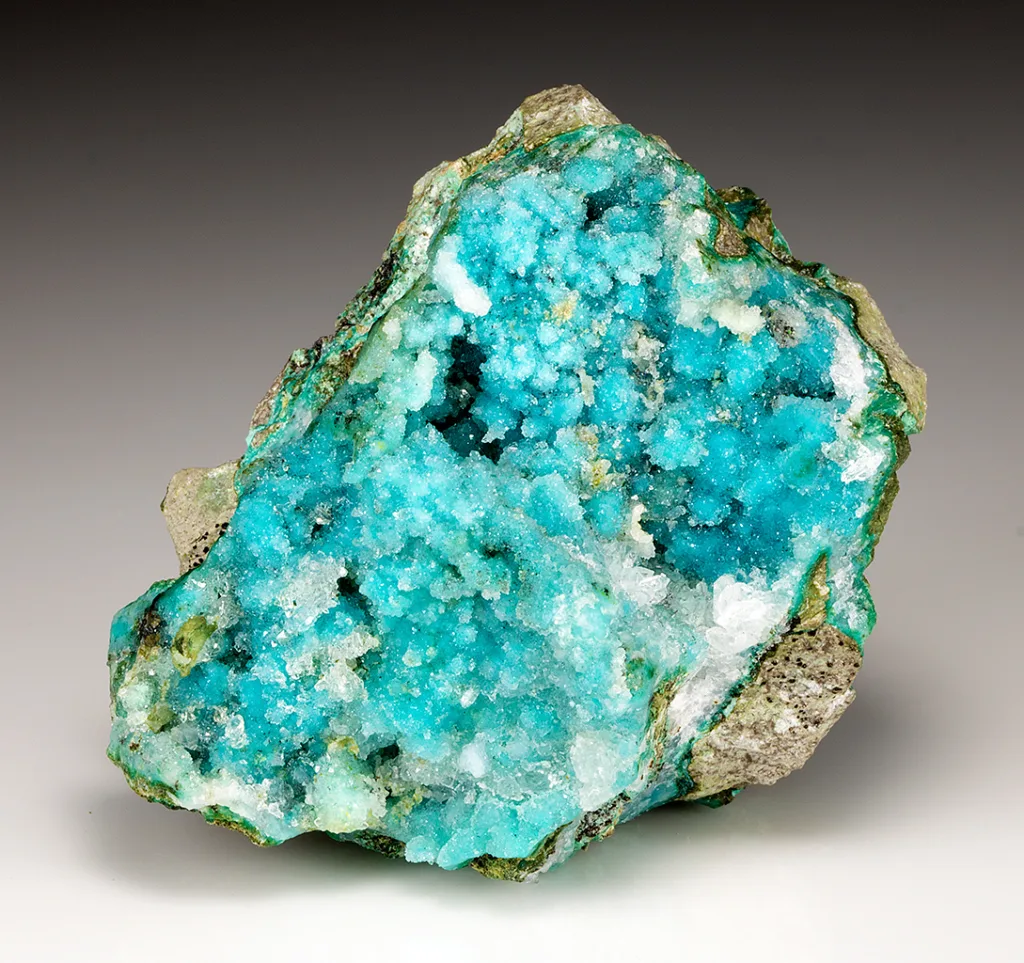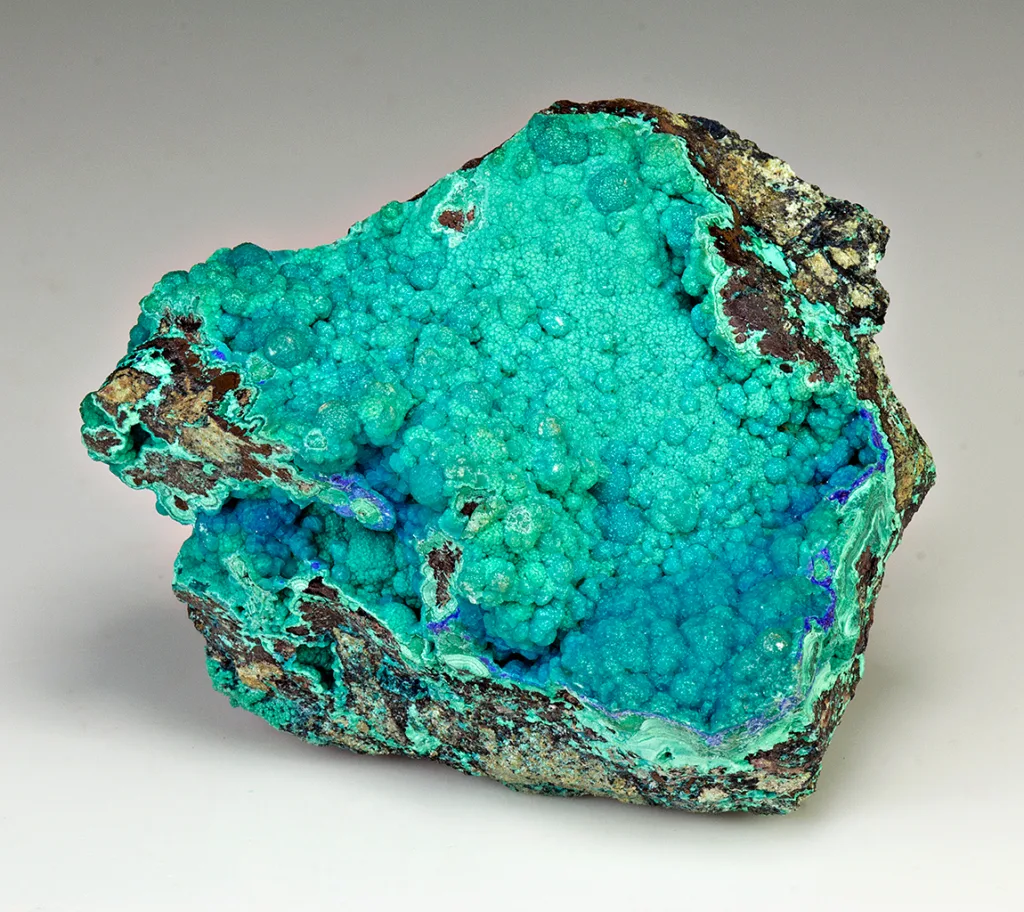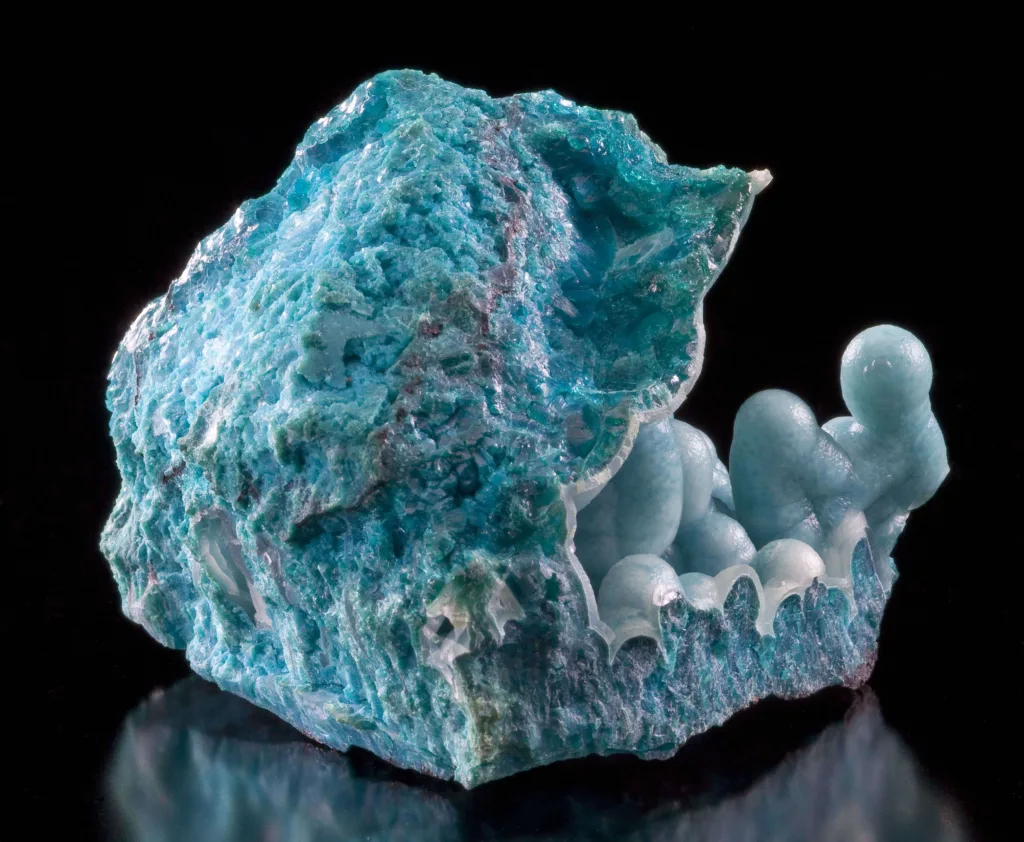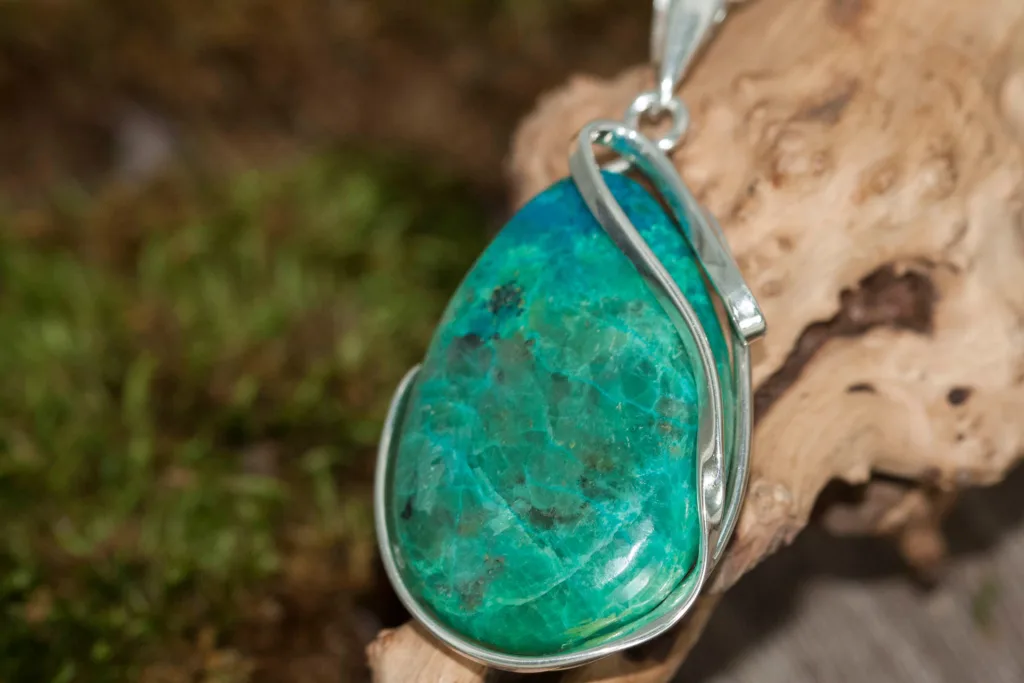Chrysocolla is a mineral that belongs to the silicate mineral group. It is often found in association with other secondary copper minerals, such as malachite, azurite, and cuprite. Chrysocolla is known for its vibrant blue-green or green color, which is reminiscent of turquoise. It is named after the Greek words “chrysos,” meaning gold, and “kolla,” meaning glue, due to its historical use as a flux in soldering gold.



Chrysocolla is formed as a secondary mineral in the oxidation zones of copper ore deposits. It is commonly found in the form of botryoidal or crust-like masses, as well as in fibrous or vein-like structures. It has been used as a decorative stone and in jewelry due to its attractive colors.
Chemical Composition: It has a complex chemical composition and can vary in its exact composition. Its chemical formula is often written as (Cu,Al)2H2Si2O5(OH)4·nH2O, indicating the presence of copper (Cu), aluminum (Al), silicon (Si), oxygen (O), and hydrogen (H), along with water molecules (H2O). The “n” in the formula represents the variable amount of water present, which can vary from specimen to specimen.
The presence of copper gives chrysocolla its characteristic blue and green colors. Other elements, such as iron, manganese, and calcium, can also be present in trace amounts, leading to variations in color and composition.
Physical Properties: It has several physical properties that can be observed and used for identification purposes:
- Color: exhibits a wide range of colors, including blue, green, turquoise, and sometimes brown or black. The colors are often mottled or banded.
- Luster: It has a vitreous to dull luster, depending on the specimen and its surface characteristics.
- Transparency: is typically translucent to opaque, with varying degrees of transparency.
- Crystal System: does not crystallize in distinct crystal forms. Instead, it commonly occurs in amorphous or botryoidal masses, as well as in fibrous or vein-like structures.
- Hardness: On the Mohs scale, It has a hardness ranging from 2.5 to 3.5. It is relatively soft and can be easily scratched by harder minerals.
- Cleavage: exhibits poor or absent cleavage. Instead, it tends to fracture or break irregularly.
- Density: The density of chrysocolla ranges from 2.0 to 2.4 grams per cubic centimeter, which is relatively low.
- Other Properties: It is known for its low specific gravity, meaning it feels lighter compared to other minerals of the same size. It is also infusible, meaning it does not melt when subjected to heat.
These physical properties, along with the chemical composition, help in distinguishing chrysocolla from other minerals and identifying it in various geological contexts.
Chrysocolla Formation and Occurrence
Formation Processes
- Hydrothermal Processes: It can form through hydrothermal processes, which involve the interaction of hot water-rich solutions with existing minerals in the Earth’s crust. In these processes, copper-rich solutions permeate through fractures and voids in the rocks, reacting with primary copper minerals and depositing chrysocolla as a secondary mineral.
- Supergene Processes: Supergene processes refer to the weathering and alteration of minerals near the Earth’s surface. Chrysocolla can be formed through the oxidation of primary copper minerals, such as chalcopyrite or bornite, in the presence of oxygen-rich water. The oxidized copper minerals undergo chemical reactions, leading to the formation of chrysocolla.
- Secondary Deposition: It can also be formed as a result of the leaching and redeposition of copper minerals. When copper-bearing rocks are exposed to acidic or copper-rich waters, the copper ions can dissolve and migrate through the surrounding rocks. As these solutions encounter suitable conditions, such as changes in pH or contact with other minerals, they can deposit chrysocolla as a secondary mineral.
Geological Environments
- Primary Deposits: Chrysocolla can be found in primary copper deposits, which are formed by magmatic or hydrothermal processes. These deposits typically occur in association with other copper minerals, such as chalcopyrite, bornite, or chalcocite. Chrysocolla can form as a secondary mineral in the oxidized zones of these primary deposits.
- Secondary Enrichment Zones: It is commonly found in secondary enrichment zones. These zones are formed when weathering and alteration processes cause the leaching and concentration of copper minerals from primary deposits. The copper-rich solutions migrate downward and accumulate in the lower parts of the weathered zone, leading to the formation of secondary copper minerals like chrysocolla.
- Associated Minerals and Rocks: It is often associated with other secondary copper minerals, including malachite, azurite, cuprite, and native copper. It can occur as coatings, veins, or masses within host rocks, such as sandstones, shale, and other copper-bearing rock formations. Chrysocolla can also be found as a replacement mineral within fractures and voids in rocks, where it fills the available space.
Overall, the formation and occurrence of chrysocolla are closely tied to the presence of copper minerals and specific geological conditions that facilitate the deposition and concentration of copper-rich solutions.
Chrysocolla Mineralogical Characteristics
Crystal Structure: Chrysocolla does not have a well-defined crystal structure and often occurs in amorphous or botryoidal masses. It belongs to the silicate mineral group and is classified as a phyllosilicate, specifically a member of the kaolinite-serpentine group. The lack of a distinct crystal structure is due to its formation as a secondary mineral under various conditions.
Mineral Associations: Commonly associated with other secondary copper minerals, as well as certain primary copper minerals. Some minerals frequently found alongside chrysocolla include:
- Malachite: Often occurring together, chrysocolla and malachite can form botryoidal or banded masses, with chrysocolla typically displaying blue or green colors and malachite exhibiting green hues.
- Azurite: Chrysocolla and azurite are frequently found in close association, forming vibrant blue and green specimens.
- Cuprite: Chrysocolla can be found alongside cuprite, which is a primary copper oxide mineral. The combination of chrysocolla’s green or blue color with cuprite’s red color creates visually striking specimens.
- Quartz: Chrysocolla can occur alongside quartz in some deposits, often forming botryoidal or crust-like masses with a combination of blue-green chrysocolla and translucent quartz.
Physical Appearance and Color Variations: Exhibits various physical appearances and color variations, including:
- Botryoidal Masses: Commonly forms as rounded, botryoidal masses with a smooth, globular texture. These masses can range in size from tiny spheres to larger, more substantial formations.
- Crust-like or Stalactitic Forms: It can also be found as crust-like or stalactitic formations, often coating the surfaces of rocks or filling voids within them.
- Fibrous or Vein-like Structures: In some occurrences, chrysocolla forms fibrous or vein-like structures within host rocks, appearing as delicate threads or vein networks.
- Color Variations: Chrysocolla displays a wide range of colors, including blue, green, turquoise, and sometimes brown or black. The color variations arise from the presence of different impurities, such as copper, iron, or manganese.
Optical Properties: Exhibits various optical properties, including:
- Transparency: It is typically translucent to opaque, with varying degrees of transparency. Thinner, more delicate specimens may be more translucent, allowing light to pass through partially.
- Luster: Chrysocolla possesses a vitreous to dull luster, depending on the specimen and its surface characteristics. The luster may appear more glassy or resinous in polished or cut specimens.
- Refractive Index: The refractive index of chrysocolla is relatively low due to its amorphous nature. However, precise numerical values for its refractive index are not commonly reported due to the lack of well-formed crystals.
- Birefringence: It is generally non-birefringent, meaning it does not exhibit double refraction.
- Pleochroism: Chrysocolla is typically not pleochroic, meaning it does not show different colors when viewed from different angles.
These mineralogical characteristics contribute to the visual identification and distinction of chrysocolla from other minerals.
Chrysocolla Geological Significance and Uses
Indicator of Copper Mineralization: Important mineral in the field of economic geology as it can serve as an indicator of the presence of copper mineralization in an area. Its occurrence, along with other secondary copper minerals like malachite and azurite, suggests the potential for primary copper deposits nearby. Geologists often use the presence of chrysocolla as a guide to locate areas with copper mineralization and explore for potential ore deposits.
Geological Significance in Ore Deposits: While chrysocolla itself is not a significant copper ore mineral, its presence can be indicative of the presence of primary copper deposits in the surrounding area. Chrysocolla forms as a secondary mineral during the weathering and alteration of primary copper minerals in the upper parts of ore deposits. Therefore, its occurrence can provide valuable information about the geological history, alteration processes, and potential mineralization zones within a deposit.
Gemological and Ornamental Uses: Chrysocolla’s vibrant blue-green or green colors and attractive patterns make it a popular gemstone and ornamental material. It is often cut and polished into cabochons, beads, and other jewelry pieces. Chrysocolla’s unique colors and patterns, especially when combined with other copper minerals like malachite or azurite, create visually striking gemstones and decorative objects.
Industrial Applications: Limited industrial applications due to its softness and lack of durability. However, it is occasionally used in small-scale applications such as inlay work, ornamental carvings, and artistic projects. Additionally, chrysocolla’s attractive colors and patterns make it sought after by lapidaries and collectors for its aesthetic value.
It is important to note that while chrysocolla has gemological and ornamental uses, its primary significance lies in its geological and mineralogical context as an indicator of copper mineralization and its association with ore deposits.
Chrysocolla Deposits Worldwide
Major Deposits and Locations: Chrysocolla deposits can be found in various regions around the world. Some of the major deposits and locations include:
- Arizona, USA: The state of Arizona is known for its significant chrysocolla occurrences, particularly in the copper mining districts of Morenci, Globe-Miami, and Bisbee.
- Democratic Republic of Congo (DRC): The DRC has notable chrysocolla deposits, often associated with copper mineralization in the Katanga Copperbelt region.
- Peru: Chrysocolla can be found in several mining districts in Peru, including the Yanacocha Mine in the Cajamarca region and the Cerro de Pasco Mine in the Pasco region.
- Australia: Chrysocolla deposits are found in various locations in Australia, including the Mount Gunson and Moonta mines in South Australia and the Whim Creek and Starra mines in Western Australia.
- Mexico: Mexico has chrysocolla occurrences in several mining areas, such as the Cananea Mine in Sonora and the Milpillas Mine in Sonora.
These are just a few examples of the major chrysocolla deposits worldwide, and the mineral can be found in other regions as well.
Geological Setting of Deposits: Chrysocolla deposits are typically associated with copper mineralization and occur in specific geological settings. The deposits are commonly found in areas where primary copper minerals have undergone weathering and alteration processes. The geological setting of chrysocolla deposits can include:
- Porphyry Copper Deposits: Chrysocolla can occur in the upper parts of porphyry copper deposits, where primary copper minerals have undergone weathering and oxidation.
- Volcanic and Hydrothermal Systems: Chrysocolla can be found in volcanic or hydrothermal systems associated with copper mineralization. Hot fluids carrying copper ions can interact with host rocks, resulting in the formation of chrysocolla as a secondary mineral.
- Oxidized Zones of Copper Deposits: Chrysocolla is often found in the oxidized zones of copper deposits, where primary copper minerals have been altered by weathering, leaching, and secondary enrichment processes.
Mining and Extraction Techniques: Chrysocolla is not typically mined specifically for its economic value. It is often extracted as a byproduct of copper mining operations or as part of the processing of copper ore. The mining and extraction techniques employed for chrysocolla are therefore similar to those used for copper.
In open-pit or underground copper mining, the ore-bearing rocks are extracted and transported to a processing plant. The copper-bearing rocks are crushed, ground, and subjected to various processes, including flotation, leaching, and solvent extraction, to obtain copper concentrate. During these processes, chrysocolla may be recovered along with other copper minerals present in the ore.
Environmental Considerations: Mining and extraction of copper, including chrysocolla recovery, can have environmental considerations and impacts. These can include:
- Habitat Disruption: Mining activities can disrupt natural habitats and ecosystems, particularly in open-pit mining operations. The clearing of vegetation, excavation of land, and disposal of waste materials can result in habitat loss and fragmentation.
- Water Contamination: Mining activities can generate acidic drainage or release potentially harmful chemicals into water bodies if not properly managed. This can affect water quality and aquatic life in nearby streams, rivers, and groundwater.
- Air Pollution: Dust and emissions from mining operations, as well as the use of heavy machinery and vehicles, can contribute to air pollution if not adequately controlled.
- Waste Management: The proper management of mining waste, including tailings, is crucial to prevent environmental contamination. Tailings can contain trace elements
Chrysocolla as a Gemstone and Ornamental Material

Gemological Properties: Possesses several gemological properties that contribute to its desirability as a gemstone and ornamental material. These properties include:
- Hardness: Hardness ranging from 2 to 4 on the Mohs scale, making it relatively soft compared to other gemstones. Its softness means that it requires careful handling and protection from scratches.
- Color: Chrysocolla is known for its vibrant blue and green colors, often with intricate patterns and banding. The intensity and variation of color can vary depending on the specific deposit and the presence of impurities.
- Transparency: Typically translucent to opaque, with varying degrees of transparency. Thinner and more delicate specimens may exhibit greater translucency, allowing light to pass through partially.
- Luster: Vitreous to dull luster. The surface of the gemstone can be polished to enhance its shine and reflectivity.
Cutting, Polishing, and Jewelry Use: Chrysocolla is cut and polished into various shapes and forms to be used in jewelry and ornamental pieces. The cutting and polishing process requires skilled lapidaries due to the softness and delicate nature of the material. Common cutting styles for chrysocolla include cabochons, beads, carvings, and inlays.
Jewelers often use chrysocolla in combination with other gemstones or metals to create unique and visually appealing jewelry designs. It is frequently set in sterling silver or other metal settings to showcase its vibrant colors. Chrysocolla’s patterns and colors, especially when combined with other copper minerals like malachite or azurite, can create eye-catching and distinctive jewelry pieces.
In addition to jewelry, chrysocolla is also used as an ornamental material in the production of decorative objects, such as vases, bowls, and sculptures. Its unique patterns and colors make it sought after by collectors and artisans for its aesthetic value.
Market Value and Demand: The market value and demand for chrysocolla can vary depending on factors such as the quality, size, color, and rarity of the gemstone. Generally, it is considered a semi-precious gemstone, and its value is influenced by factors such as the intensity and variation of its colors, the presence of desirable patterns or banding, and the craftsmanship of the cut and polish.
It is important to note that the market for chrysocolla is relatively niche compared to more well-known gemstones. Its value is also influenced by factors such as consumer preferences and trends. As with any gemstone, the market value of chrysocolla can fluctuate based on supply and demand dynamics.
Overall, chrysocolla’s unique colors and patterns, combined with its use as a gemstone and ornamental material, contribute to its market value and demand among collectors, jewelry enthusiasts, and artisans.
FAQ
Is chrysocolla a rare gemstone?
It is not considered a rare gemstone. While high-quality specimens with intense colors and unique patterns can be relatively rare and more valuable, chrysocolla is generally more abundant compared to other gemstones.
How do I care for chrysocolla jewelry?
It is a relatively soft gemstone, so it requires gentle care. Avoid exposing it to harsh chemicals, extreme temperatures, and prolonged sunlight. Clean chrysocolla jewelry with a soft cloth and mild soap, avoiding harsh cleaners and ultrasonic cleaners.
Can chrysocolla be used in engagement rings?
Chrysocolla is not commonly used in engagement rings due to its softness. It may not withstand the daily wear and tear associated with an engagement ring. However, chrysocolla can be used in other types of jewelry pieces, such as pendants or earrings.
Does chrysocolla have any metaphysical properties?
Believed to have various metaphysical properties, including promoting emotional balance, communication, and empowerment. It is often associated with the throat chakra and is said to aid in self-expression and creativity. However, the metaphysical properties of gemstones are subjective and not scientifically proven.
Can chrysocolla change color over time?
Generally stable and does not undergo significant color changes over time. However, like many gemstones, it is best to protect chrysocolla from prolonged exposure to sunlight, as excessive UV radiation can potentially affect its color.
Are there synthetic or treated chrysocolla gemstones?
It is not commonly synthesized or treated. Most chrysocolla gemstones available on the market are natural. However, some specimens might undergo stabilization processes to enhance their durability and prevent further degradation.
Can chrysocolla be faceted?
Chrysocolla is not typically faceted due to its softness and lack of durability. It is more commonly cut and polished into cabochons, beads, and other smooth shapes that showcase its colors and patterns.
Are there any famous chrysocolla gemstones or artifacts?
While there are no specific famous chrysocolla gemstones or artifacts that are widely recognized, chrysocolla has been used in various jewelry designs and ornamental objects throughout history.
What is the largest chrysocolla specimen ever found?
There is no specific record of the largest chrysocolla specimen ever found. Chrysocolla can occur in various sizes, and large specimens have been discovered in different locations around the world.




































